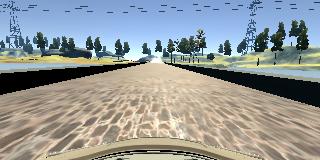The goals / steps of this project are the following:
- Use the simulator to collect data of good driving behavior
- Build, a convolution neural network in Keras that predicts steering angles from images
- Train and validate the model with a training and validation set
- Test that the model successfully drives around track one without leaving the road
- Summarize the results with a written report
For my model, I am using the Network Architecture published by the Nvidia team. Which consists of normalization layer followed by five convolution layer and finally three fully connected layer.
Small modification I made to the Nvidia architecture, I added drouput of 25% right after the fifth convolutional layer before being flattened. This was to prevent the model from over fitting.
| Layer (type) | Output Shape | Param # |
|---|---|---|
| lambda_1 (Lambda) | (None, 160, 320, 3) | 0 |
| cropping2d_1 (Cropping2D) | (None, 65, 320, 3) | 0 |
| convolution2d_1 (Convolution2D) | (None, 31, 158, 24) | 1824 |
| convolution2d_2 (Convolution2D) | (None, 14, 77, 36) | 21636 |
| convolution2d_3 (Convolution2D) | (None, 5, 37, 48) | 43248 |
| convolution2d_4 (Convolution2D) | (None, 3, 35, 64) | 27712 |
| convolution2d_5 (Convolution2D) | (None, 1, 33, 64) | 36928 |
| dropout_1 (Dropout) | (None, 1, 33, 64) | 0 |
| flatten_1 (Flatten) | (None, 2112) | 0 |
| dense_1 (Dense) | (None, 100) | 211300 |
| dense_1 (Dense) | (None, 50) | 5050 |
| dense_1 (Dense) | (None, 10) | 510 |
| dense_1 (Dense) | (None, 1) | 11 |
The model used an adam optimizer, so the learning rate was not tuned manually.
Training data was chosen to keep the vehicle driving on the road. I used the center image but found out that the vehicle was leaning towards one side of the road. Therefore I also flipped the image and multplied the steering angle by -1. Also I drove around the track couple of times to collect the data and turned the car around to gather the data driving the car around the track backwards.
For Example the image below had the steering angle of 1.405709. What I did was flipped the image using numpy library and multilplied the steering angle by -1. So the flipped image would have the steering angle of -1.405709
After following the tutorial and implementing the Nvidia Archtecture, the car was predicting the angles pretty well. To improve and have the car be able to drive around the track without leaving the road, I had to crop the images, to get rid of parts of images that were irrelevant. On the top portion of the images, it capture big chunks of the sky, which I came up with the conclusion that it can be discarded and also the bottom portion of the image was made up with the hood of the car, which I discarded as well.
I also normalized the images, and this significantly improved the results. Finally, I improved the overall data. The way I improved the data, was by driving around the track couple times, than driving around the track backwards couple of times, and finally recording data of turning sharp turns couple times as well. With these implementations, my car was able to drive around the track without leaving the road or crashing.
The Model Architecture has five convolution layer followed by three fully connected layer that outputs the control value. The first three convolution layer is a convolution layers with a 2x2 strides and a 5x5 kernel. And finally the last two convolutional layer is non strided layer with 3x3 kernel. All these convolutional layers use relu activation.
After the convolutional layer it's followed by three connected layer that outputs the control value.
To capture good driving behavior, I first recorded two laps on track one using center lane driving. After second lap, I stopped the car and drove around the track in other direction for two more laps.
After collecting the data, I flipped the image array and mutlplied the angle of the steering wheel by -1. This helped my car from leaning more towards one direction and also doubled the data I collected.
After collecting the data, I shuffled the data and also split the data for training and testing. Where 20% of the data was set aside for the test.

